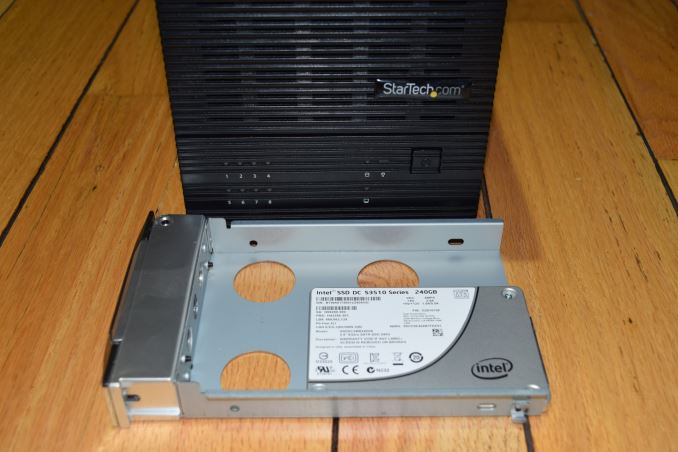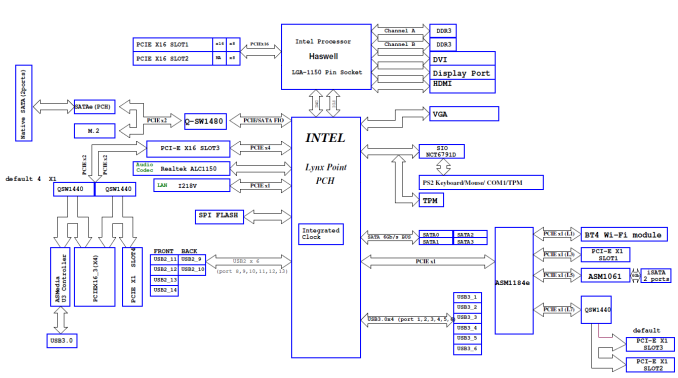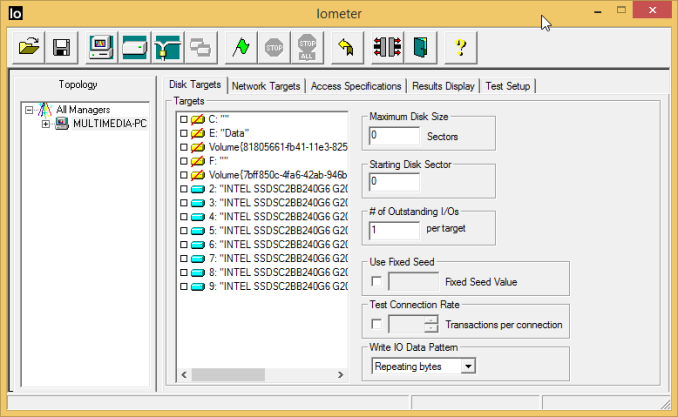StarTech.com 8-bay USB 3.0 / eSATA Removable Hard Drive Enclosure Review
by Ganesh T S on August 11, 2015 8:00 AM EST- Posted in
- Storage
- USB 3.0
- eSATA
- DAS
- StarTech.com
Testbed Setup and Evaluation Methodology
Evaluation of the DAS enclosure must be done keeping the use-case in mind. This is not the sort of storage system in which one would even attempt to do reads and writes simultaneously. The typical usage scenario involves either writing a lot of data into the member drives in a backup process, or reading the archived data back. In order to get an idea of the performance of the DAS, we fill up the enclosure with 240GB Intel DC S3510 SSDs and first process our AnandTech DAS Suite on the first drive in the array. It is also possible that a use-case attempt to read or write a number of drives simultaneously. That scenario is tested out using IOMeter.
| AnandTech DAS Testbed Configuration | |
| Motherboard | Asus Z97-PRO Wi-Fi ac ATX |
| CPU | Intel Core i7-4790 |
| Memory | Corsair Vengeance Pro CMY32GX3M4A2133C11 32 GB (4x 8GB) DDR3-2133 @ 11-11-11-27 |
| OS Drive | Seagate 600 Pro 400 GB |
| Optical Drive | Asus BW-16D1HT 16x Blu-ray Write (w/ M-Disc Support) |
| Add-on Card | Asus Thunderbolt EX II |
| Chassis | Corsair Air 540 |
| PSU | Corsair AX760i 760 W |
| OS | Windows 8.1 Pro |
| Thanks to Asus and Corsair for the build components | |
The full details of the reasoning behind choosing the above build components can be found here.
Note that the USB 3.0 port hanging off the PCH of the testbed is indeed capable of UASP (USB-attached SCSI Protocol). The screenshot below shows the information about a SSD in the enclosure, as viewed through the USB 3.0 port. We find that UASP is enabled, and S.M.A.R.T passthrough works.
In the eSATA mode, we used the only freely available SATA port in our testbed. It was the one connecting to the Lynx Point PCH through a PCIe 2.0 x1 link (the path with the ASM1184e and the ASM1061 bridge chips in the board layout below). Luckily, it turned out that the ASM1061 does support port multiplication and there was no issue getting the enclosure to work with an eSATA connection.
One of the ways to evaluate performance for simultaneous access to multiple disks in the array would be to configure a software RAID volume with the member disks. Unfortunately, the disks are recognized by Windows as 'Removable Disks' and the Disk Management feature doesn't allow software RAID to be configured with the disks present in the enclosure. Hence, we decided to go with IOMeter, and access the eight disks as physical drives without partitions.
Four IOMeter traces were processed and the transfer rates as well as the average latencies / response times were recorded:
- 128K sequential writes with a queue depth of 4
- 128K sequential reads with a queue depth of 4
- 4K random writes with a queue depth of 32
- 4K random reads with a queue depth of 32














21 Comments
View All Comments
BMNify - Wednesday, August 12, 2015 - link
you could probably do it with the £99 Orico 9548RU3 Aluminum 4 Bay USB3.0 3.5 inch Hard Disk SATA HDD RAID Enclosure Bhttp://www.ebay.co.uk/itm/Orico-9548RU3-Aluminum-4...
alpha754293 - Tuesday, August 11, 2015 - link
Given that you seem to found a system/setup that works better for you - do you think that you would be able to re-test the Mediasonic Probox because I have a feeling that some of the speed limitations (like around 180 Mbps regardless whether it was USB 3.0 or eSATA) might be due to hardware/infrastructure/setup limitation and might not actually truly represent the performance of the enclosure?digitalgriffin - Tuesday, August 11, 2015 - link
I really don't see the benefit of spending this much. There are better and cheaper alternative external enclosures with 4 bays for < 1/2 the price for each. For example the Media Sonic HF2-SU35L handles 4 bays eSATA & USB3 for $99/each. Get two and you are at 2/3'rd the price of this one unit. If one enclosure fails you aren't SOL.Get a PCIe eSATA card with two ports/2 channels. This will offload some of the burden
These mega NAS builds are for professionals only with serious NAS storage requirements. (Business web servers, data archives, code archives, photograph databases, etc...) Again not really useful for 99.5% of the readers here. Cool to look at, but not practical for the vast vast majority of us.
herky - Tuesday, August 11, 2015 - link
I'm not sure what the Media Sonic HF2-SU35L is, because it doesn't exist. Perhaps the HF2-SU3S2 is what you were referring to? In any case, it may be cheaper but it CERTAINLY isn't better. The build quality isn't good, and far worse, the transfer speeds are awful compared to the Startech product. If you want dirt cheap, get 2 of the HF2-SU3S2. If you want something that works well, get the Startech product.As the review noted, this isn't a NAS device so I'm not sure why you are ranting about them. This is a DAS. It seems to me YOU don't need one so you don't think anyone else does either.
digitalgriffin - Thursday, August 13, 2015 - link
I know the difference between a NAS and a DAS. Most towers are more then capable of holding 10+ drives.If you honestly need that much storage space then chances are you are running a server farm for some medium to large business. In that case you want redundant backups (failover). So running something like this on a desktop environment isn't practical.
If you need more then that then you are going redundant failover NAS and adding on a DAS to that NAS when the NAS runs out of storage.
And you are correct it is a HF2-SU3S2. I never claimed it was better. Just that is was a cheaper alternative. And if one hardware case goes down, then you aren't ham stringed with the loss of 8 drives versus 4. (If you set it up properly)
Now as to your argument that just because 99.5% of us don't need it translates as "I don't need it" would be incorrect. It's a NICHE product AT BEST. If you TRULY need this much storage, then you are a profesional with mission critical data, and you aren't going to buy a niche product without top TIER 1 support, warranty, and reputation behind it.
This does not have that. Sorry.
Gigaplex - Tuesday, August 11, 2015 - link
"The product page also doesn't make it clear that a SATA chipset with port multiplier support is needed for accessing multiple disks in the array over an eSATA connection."You really need to emphasise this more. It's actually rather common for eSATA ports to not support this, especially Intel ones.
dtgoodwin - Wednesday, August 12, 2015 - link
It would be nice to see how accessing two drives at the same time affects the speed. I have an old Silicon Image SATA 300 based 4-port multiplier box (Rosewill branded). One drive has okay speed, but if I start accessing two, the switching mechanism combined with the latency of conventional hard drives mean read or write speeds drop to around 25% of their original - with only two drives being accessed. I could imagine RAID on any of these boxes with hard drives would be pretty miserable. The eSATA card that came with mine had softRAID capabilities, but I immediately flashed it to the non-RAID firmware.dzezik - Wednesday, August 12, 2015 - link
completely stupid idea and useless logic with sata multiplexer.the enclosure would be thousand time more useful with two external sas ports (each port is for 4 disks). then you dont need any chip inside, only good quality wiring and your computer can control fully all 8 disks, you can get full speed 8x6Gb/s. eSATA and SATA is completeley useless. You can buy 8 port SAS controller for $100. if You need SATA for any sake then You can use SATA disks, or You already have SATA then You can use SATA disks, SATA disks are compatible with SAS controllers. but it is good idea to buy SAS disks instead SATA, the price is almost the same, I mean the same model with SATA and SAS are only 2-5% differrence in price. if You prefer very low performance disks like WD-RED then You stick with SATA, but all 7200 disks are available with SAS and SATA. please remember SAS are not only faster (full duplex, SATA is half duplex - cant read and write at the same time) but are more solid, accept longer cables and have more advanced error correction.
experttech - Thursday, August 13, 2015 - link
So if I move all 6 SATA drives that I have in my computer case to a DAS, will I lose any data or will Windows show up these 6 drives as though they were attached to the internal SATA connections in my case? Also is there one connection from the DAS to the computer case? If so, wouldnt operating multiple drives in tandem be a problem since the available bandwidth (USB 3/ eSATA etc) are limited?Jorsher - Friday, August 14, 2015 - link
This looks like a neat product. Typically I would avoid things from brands that aren't well-known, and that would include Star Tech, but...The only item I've purchased from this company was a 25u 4-post server rack for my home setup. Their packaging could be improved, as two arrived with over 50% of the parts missing. Of course, the fault lies with the couriers (one attempt with UPS, one with FedEx). As far as the rack itself -- it was a great price and while it is a no-frills rack, it's very well-built. It's holding a large rackmount PSU, a filled 24-bay storage enclosure/server, two switches, rackmount PDU, patch panels, and even a monitor and keyboard up top and is very sturdy. I will consider their other products in the future.